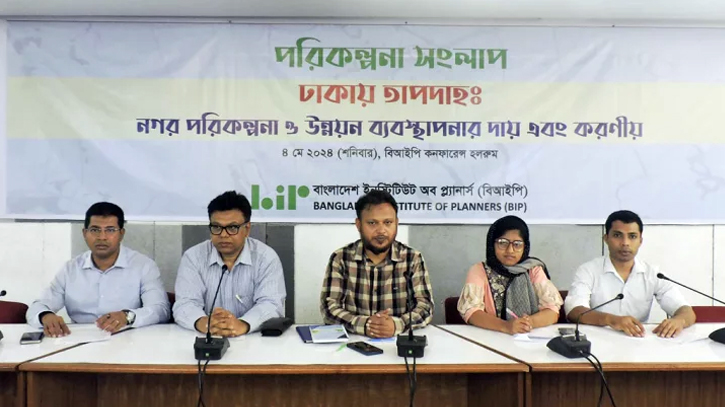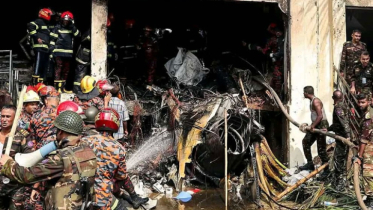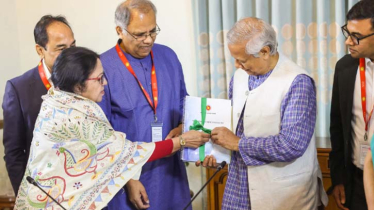
Photo: Courtesy
Three decades ago, more than 20 percent of Dhaka's total area was covered by wetlands. It has gradually fallen below 3 percent. In other words, wetlands in Dhaka have decreased by 17 percent in three decades.
On the other hand, to ensure the livability of a city, 25 percent of the city's total land must be covered with greenery. Dhaka city now has only 9 percent.
These findings stem from a study conducted by the Bangladesh Institute of Planners (BIP), an organisation comprising urban planners. The outcomes of this research were unveiled during a planning dialogue held at the Banglamotor BIP office in the capital on Saturday (4 May) afternoon.
According to urban planning standards, an ideal city should allocate 25 percent of its area to green spaces and maintain 10 to 15 percent as water bodies. However, based on BIP's research, in 1995, Dhaka city boasted over 52 square kilometers of green areas and open spaces. Presently, this has decreased by approximately 43 percent compared to 1995, now standing at around 30 square kilometers. Additionally, in 1995, over 20 percent of Dhaka city's total area comprised wetlands. Presently, this figure has plummeted to a mere 2.9 percent. Shockingly, about 86 percent of the wetlands across the two city corporation areas of Dhaka have been filled up with sand over the past three decades.
The Bangladesh Institute of Planners (BIP) conducted the study in 2023, revealing a concerning trend: while green areas and water bodies have diminished, concrete-covered areas have expanded in Dhaka city. Over the past three decades since 1995, the concrete cover in Dhaka has surged by approximately 76 percent.
In yesterday's planning dialogue, BIP President Professor Adil Muhammad Khan delivered the keynote address titled 'Dhaka Heatwave: Responsibilities and Actions of Urban Planning and Development Management'. In his presentation, he highlighted that over the past two decades, the proportion of gray areas and concrete in Dhaka has risen significantly. Specifically, the concrete-covered area constituted 64.99 percent in 1999, escalating to 81.82 percent by 2019.
Later in the discussion, Professor Adil Muhammad remarked that in numerous instances, the protector has turned into the predator. Government agencies have been responsible for filling water bodies and encroaching upon land under the guise of development. He emphasised the lack of accountability in the development activities of government agencies, highlighting their disregard for input from civil society and professionals. Professor Adil Muhammad also expressed that the situation has become so dire that even the two mayors of Dhaka may feel powerless in certain cases.
Adil Muhammad Khan expressed skepticism regarding the possibility of transforming Dhaka into an ideal livable city given the current circumstances. He remarked that while it may seem feasible to address immediate issues and maintain the city's operations with minor efforts, substantial planning is necessary for the extended Dhaka area (comprising the new area joining the two city corporations) and the Purbachal New City project. However, he emphasised that achieving this goal requires a fundamental prerequisite: political will.
The situation has been deteriorating:
According to the study conducted by BIP, Dhaka is experiencing exacerbated heat waves due to uncontrolled and unplanned urbanisation. Responsibility for this phenomenon falls on individuals, private groups, and government agencies alike. Despite the existence of numerous laws and policies aimed at controlling development, the situation continues to worsen due to ineffective implementation.
BIP has underscored several key factors contributing to the heat wave in Dhaka. These include the failure to safeguard green areas and water bodies through effective urban planning and land use strategies, an excessive surge in concrete infrastructure, the negligence of government agencies in planning implementation, development control, and monitoring, instances of corruption and dereliction of duty, uncoordinated development initiatives by urban bodies, the lack of environmental and climate considerations in building design, as well as the prevalence of glass-framed and air-conditioned (AC-dependent) building designs and inadequate ventilation in marginal and low-income areas.
BIP has put forth several proposals aimed at mitigating the incidence of heatwave in Dhaka. These include giving paramount importance and priority to the preservation of existing green spaces and water bodies, implementing effective measures to reclaim encroached canals and green areas, devising and enforcing greening master plans in urban zones, revising building construction regulations to enhance opportunities for greenery and afforestation between residential areas and structures, and halting the construction of high-rise buildings along roadways. Additionally, BIP emphasizes the need to hold planners, architects, and engineers accountable for ensuring proper adherence to urban planning and building construction standards.
Messenger/Shova/Howlader








